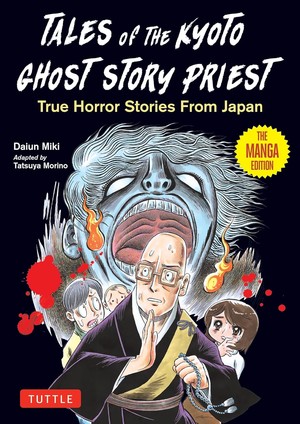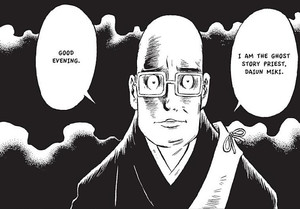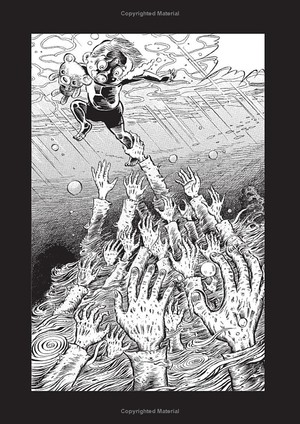The Spring 2025 Manga Guide
Tales of the Kyoto Ghost Story Priest
What's It About?

Tales of the Kyoto Ghost Story Priest has a story by Daiun Miki and art by Tatsuya Morino, with English translation by Tuttle Publishing. Published by Tuttle Publishing (April 1, 2025). Rated T.
Is It Worth Reading?
Rebecca Silverman
Rating:

The author of this book is, in fact, a practicing Buddhist priest – the head priest of Renkyuji Temple in Kyoto, to be exact. Apparently he's made a name for himself as a purveyor of ghost stories as a means of sermonizing his faith, and while I tend to be skeptical of any organized religion, I have to admit that this is a decently fun way to go about it. Per the back of the book, he regularly appears on radio and television programs, and now he's branching out into manga with the help of horror manga creator Tatsuya Morino. That said, if you're no fan of proselytizing of any sort, Tales of the Kyoto Ghost Story Priest may rub you the wrong way, because Miki ends more than a few of his stories with a bit of moralizing and the answer to the ghosts plaguing the people who seek him out is “prayer.”
Of the eleven stories contained in the volume, two are autobiographical and two are related to each other, while the rest stand alone as one-offs. The two pieces about Miki's own experiences are among the shortest, but also most interesting; we can really see where his approach to reaching people comes from. Of the two, the one set during his adult life is the more interesting, as it deals with his ability to smell impending death, something which he's reluctant to view as supernatural given that others can smell seasons or weather. But the lack of religious trappings in the story makes it stand out as a story about someone earnestly trying to do good just because. While there's never any sense that Miki is trying to use his religion for profit, the lack of it still makes the tale stand out.
That said, my favorite piece in the book is the two-part “Kooh the Bear.” This one is about a fisherman who believes he was saved from drowning by his beloved stuffed bear as a child. The bear was lost to the sea, but years later, the man's kindergarten-age son was swept out to sea by a rogue wave and miraculously returned, telling a story about a bear who was with him the whole time. Apart from the wonderful idea that a beloved toy can return love, this story validates the attachment we can feel to an object, something borne out by the conclusion wherein Miki suggests that memorializing the bear and making offerings is the best way to thank it. The bear may be stuffed, but it's still important and worthy of love, and that's a nice message.
While the translation feels a little rougher than some of Tuttle's other books, this is still very well put together, with a firm cover, thick pages, and tight binding. The art has a sort of campy feel that works, and while this won't scare you, it does a pretty good job of putting things into perspective.
Kevin Cormack
Rating:

Who doesn't love a good campfire spooky story? I spent much of my childhood camping with the Scouts, and a major highlight of those chaotic, exhausting weekends was the colorful night-time tales of the supernatural told by smirking leaders with the intention of keeping entire groups of terrified eleven-year-olds from sleeping soundly in their tents. Tales of the Kyoto Ghost Story Priest is a relatively tame collection of supposedly true stories collected and retold by Daiun Miki, a celebrity in Japan. Most stories in this collection are more unsettling than truly horrifying, which gives them an almost cozy vibe, with a deliciously macabre edge. This isn't dumb slasher horror, but stories that skirt the borders between life and death, of curses and grudges, of unexplained illnesses and inexplicable happenings.
Each story is narrated by Miki himself, who appears in-panel, often interacting with the other characters whose stories are related via his recollections. It's an effective storytelling technique, and he presents as a trustworthy, wise, and compassionate man whom it seems likely others would seek out for help.
Sometimes Miki ends a tale with an allusion to Buddhist philosophy, which has the potential to come across as a little patronizing (it's not dissimilar to the cheesy moral messages awkwardly appended to 1980s US cartoon episodes), but mostly adds to the vibe: an unusual mixture of unease and reassurance, not unlike my Scout campfire tales of old. Morino's art is simple, almost retro in its aesthetics, which suits the volume well. His exaggerated, cartoony facial expressions are both amusing and horrifying, with some genuinely interesting imagery (I especially liked the pair of stories about the teddy bear.)
My only criticism is of the extremely clunky, clumsy translation. Sometimes speech bubbles appear to be out of order, which ruins the flow of the storytelling. The language is also stilted as no human translator is listed in the credits. Therefore, I have no choice but to knock an entire star off my rating.
discuss this in the forum (28 posts) |
back to The Spring 2025 Manga Guide
Seasonal homepage / archives